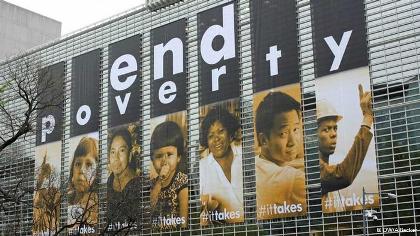More than the last 200 years the world as a whole has seen a marked turn down in the incidence of absolute poverty. The success of Western Europe and North America over the 19th and 20th Centuries in reducing absolute poverty is famous, as is the success of China and India in more recent times. We have also seen encouraging signs of faster development against poverty in much of Africa since the late 1990s. The proportion of the world's population living below $1 a day has fallen from over 80 percent in the early 19th century to under 20 percent today.

In the 'utility of poverty' interpretation, some people are poor largely since the choices they make and there is little reason to think that they have the potential to be anything else than poor; And their poverty is seen as essential for the country's economic success that requires a large number of people eager for work, and avoiding hunger is seen as a necessary incentive for doing that work. The view of Patrick Colquhoun (1806), the founder of the modern police force, is a fair representation: "Poverty is a most necessary and indispensable ingredient in society, without which nations and communities might not exist in a state of civilization. It is the lot of man and it is the source of wealth". This appears to have been the dominant conventional view until well into the 19th century, and versions of this view survive today, although it is clearly no longer dominant.
Past advocates of the 'utility of poverty' saw little hope for poverty reduction through technical progress and economic development, given the claimed lack of 'moral restraint' amongst poor people. Classical economists acknowledged the logic of policies for mass education to change behaviours and therefore assure more pro-poor development in a capitalist market economy. Other than there was little enthusiasm for public intervention to foster basic schooling for all children until the late 19th century. There was reasonably broad support within elites for policies that helped protect people from transient poverty due to downside risks even when mass poverty was taken for granted. Other than public action to reduce chronic poverty had few advocates.
The second, option, interpretation sees poverty as stemming in large part from market and other institutional failures; one version came to prominence in the socialist movements of mid-19th century, whereby poverty was seen as an inevitable consequence of capitalism. Likewise to the classical economists, Karl Marx was skeptical of the prospects of poverty-reducing enlargement under capitalism, but not since of the moral failings of poor people; rather he believed that full-employment would be impossible, and 'reserve army' of the unemployed would hold back any wage gains.
Steps in the transition
The dominance of the institutional-failures view was highly uneven over time, with long periods of inaction and numerous set-backs. Though, two significant historical steps can be identified, which I dub the First and Second Poverty Enlightenments. The First Poverty Enlightenment was in the 20 or so years prior to turn of the 19th century. Well-liked critiques of prevailing social hierarchies blossomed in London and Paris, in the latter case notably culminating in the French Revolution. The philosophical writings of Immanuel Kant, Jean-Jacques Rousseau, Smith and others articulated a new respect for poor people as people, not just serving some purely instrumental role as means of production. The economy itself came to be seen as a means for promote all human welfare.
Adam Smith's (An Inquiry into the Nature and Causes of the Wealth of Nations, 1776) influential critique of mercantilist view that a country's development have to be judged through its balance of trade was an important step in opening the way to seeing growth against poverty as a goal for development, rather than a threat to it. Smith also argued in favour of promotional antipoverty policies, such as public subsidies to help cover schooling costs of the 'common people'. However on this and other social issues, Smith was evidently far more progressive than most of his peers or near-term followers. Classical economists such as Thomas Malthus and David Ricardo were hostile to the idea of antipoverty policy, pointing to adverse incentive effects, even if (not for the last time) such effects were almost certainly exaggerated, for example in the intense and influential early 19th-century debates on reforming England's Poor Laws (Ravallion 2013a). While the recognition those institutions were as a minimum partly responsible for poverty was a crucial step, it will be a long time before we saw the emergence of comprehensive antipoverty policies that might promote as well as protect.

The Second Poverty Enlightenment came in the period around 1960-80, with continuing influence nowadays. This saw both a steeper pace of decline in the worldwide poverty rate and rationally stronger and better-informed arguments for antipoverty policy. Mass attention to poverty also has reached its historical peak. This is obvious if one enters the word 'poverty' in the Google Books Ngram Viewer; there was a sharp enhance in the 1960s and by the first decade of this decade references to 'poverty' as a proportion of all published words reached its highest value in 300 years, in both English and French. The institutional failures interpretation had clearly become dominant over utility of poverty. Debates are continued of course. Some till now blamed poor people for their poverty. Several did not see poverty as a global concern. Though, a reasonably broad consensus emerged that poverty was morally unacceptable and across the globe including in the newly free countries of developing world, there was new optimism about the scope for fighting poverty. Even as mistakes happened, and some optimistic but ill-conceived plans were soon discouraged, numerous policy innovations emerged in both rich and poor countries. Incentive effects were still debated, however with better evidence to draw on. A combination of straight promotional policies with robust pro-poor growth in a reasonably open market economy came to be seen as key to fighting poverty. Old-style protection policies also came to incorporate incentives for promotion, for instance transfers to compensate poor families for the costs of schooling their children.
As the foundation for the transition in thinking was laid in the First Poverty Enlightenment, it was really only by latter half of the 20th century that it came to be understood that freedom, self-fulfilment and overall prosperity required (amongst other things) that people were not supposed back by poverty and that governments had a responsibility to help promise that they were not. Philosophical and economic thought played an imperative role (in the writings of John Rawls, Amartya Sen and others), other than so too did more popular works (such as by Michael Harrington and JK Galbraith). The state was seen to have a role in assuring that all individuals had access to the essential material conditions for their own fulfilment, arguably the most important requirement for equity, but also the key to breaking out of poverty traps. Excellent public education, sound health systems and financial inclusion all came to be seen as crucial elements for next generation of poor families to escape poverty, for good.
Three mutually reinforcing factors stand out in elucidation both this shift in thinking and falling poverty incidence globally: new expertise, new knowledge and political voice. New technologies created economic opportunities and demands for new skills in the workforce, that mass schooling could provide, and a smarter workforce also needed to be healthy. New research and data on poor people influenced public thinking and policy making from the late 19th century, and too taught policymakers about the efficacy of their policy responses. Popular writings, social novels and plays also helped transform information into public awareness. Success of struggles for broad political representation came roughly hand-in-hand with better informed policy debates and better policies, and was reinforced by new facts and awareness.
Conclusions:
We live in a far less poor world than 200 years ago and it is a world that has become usually smarter at fighting poverty. The causation undoubtedly goes both ways between the progress against poverty and the transition in thinking. It is a much harder to make rapid development against poverty while there is a lot of it, and mainstream thinking 200-plus years ago might not easily entertain the idea of a world without poverty. With a number of painfully long lags (the time it took before real wage rates rose in the wake of the industrial revolution is especially notable), heavy lifting out of absolute poverty in Western Europe and North America was finally completed through technical progress, economic growth and (crucially) complementary progress in basic health and education. Opportunities were formed, and in due course policies emerged to assure that a great many people might take advantage of those opportunities. Then new options opened up for more focused and effectual direct interventions emphasising both promotion and protection. Antipoverty policies have both fuelled, and been fuelled by, rising overall wealth.
With the global incidence of extreme poverty currently at its lowest level, and public attention and knowledge at their highest point, ideal of a world free of such poverty is certainly closer than ever. But history also warns against complacency. Now as the heavy lifting in the successful developed countries of today was not easy, the poorest countries nowadays face huge challenges. With a sustained effort, building on past experience, it must be possible to come close to eliminating extreme poverty by 2030 or so. However less optimistic scenarios can also be readily identified, returning to the more sluggish progress of the past.